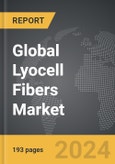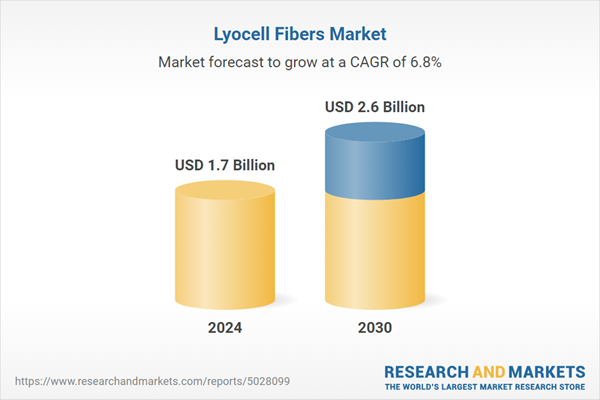Global Lyocell Fiber Market - Key Trends & Drivers Summarized
What Is Lyocell Fiber and Why Is It Revolutionizing the Textile Industry?
Lyocell fiber, a form of rayon, consists of cellulose fiber made from dissolving pulp (usually from wood) and then reconstituting it by dry jet-wet spinning. This sustainable fiber is celebrated for its environmental credentials, durability, and exceptional comfort properties. Lyocell is widely regarded in the textile industry for its softness, strength, and absorbent qualities, making it highly suitable for a vast array of applications, from clothing to home textiles. Unlike many other fibers, lyocell is produced using a closed-loop process that recycles almost all the chemicals used. Its low environmental impact aligns well with the growing global push towards sustainability. This has propelled lyocell into the spotlight as both fashion retailers and consumers seek out more eco-friendly materials that do not compromise on quality or performance.How Are Consumer Preferences Shifting Towards Sustainable Textiles?
Today's consumers are increasingly environmentally conscious, demanding products that align with a sustainable and ethical lifestyle. In the textile market, this shift is visibly impacting the demand for fibers like lyocell, which are derived from renewable wood sources and manufactured through environmentally responsible processes. The transparency in lyocell's production process and its biodegradable nature resonate well with eco-aware consumers looking to reduce their ecological footprint. Additionally, as awareness of the adverse impacts of synthetic fibers and conventional cotton on the environment grows, more consumers are turning to lyocell as a preferred alternative. This preference is supported by the fiber's comfort and performance characteristics, which meet the high standards expected from modern fabrics.What Technological Advancements Are Enhancing Lyocell Fiber Production?
The production of lyocell fiber has benefited significantly from technological advancements that have improved efficiency and environmental outcomes. Innovations in manufacturing technology have enabled the use of organic solvent recovery systems that are more effective, reducing waste and emissions compared to older methods of fiber production. Moreover, advancements in the treatment and recycling of water and solvents in the lyocell manufacturing process have set new benchmarks for sustainability in the textile industry. These improvements not only bolster the environmental profile of lyocell but also reduce the cost of production, making sustainable fibers more competitive with traditional materials. As technology continues to evolve, it is expected that lyocell will become even more sustainable and widely available, pushing the boundaries of what eco-friendly textiles can achieve.Growth in the Lyocell Fiber Market Is Driven by Several Factors
The growth in the lyocell fiber market is driven by several factors, highlighting the dynamic interplay between consumer trends, technological innovations, and industry adaptation. Rising consumer demand for sustainable and ethically produced textiles is perhaps the most significant driver, as awareness and preference for environmental stewardship continue to influence purchasing decisions. Technological advancements that enhance the sustainability and efficiency of lyocell production further stimulate this growth, making it a more viable option for manufacturers looking to meet eco-friendly standards. Additionally, the expansion of lyocell into various market segments, including fashion, industrial, and medical textiles, diversifies its applications and opens up new avenues for growth. The increasing collaboration between fashion brands and lyocell producers to develop new and innovative products is also pivotal, ensuring that lyocell remains at the forefront of the sustainable textile movement. Together, these factors contribute to a robust expansion of the lyocell market, underpinned by a commitment to sustainability and innovation.Report Scope
The report analyzes the Lyocell Fibers market, presented in terms of market value (USD). The analysis covers the key segments and geographic regions outlined below.- Segments: Fiber Type (Staple Fiber, Cross-Linked Fiber); End-Use (Apparel, Home Textiles, Surgical Products, Baby Diapers, Automotive Filters, Other End-Uses).
- Geographic Regions/Countries: World; United States; Canada; Japan; China; Europe (France; Germany; Italy; United Kingdom; Spain; Russia; and Rest of Europe); Asia-Pacific (Australia; India; South Korea; and Rest of Asia-Pacific); Latin America (Argentina; Brazil; Mexico; and Rest of Latin America); Middle East (Iran; Israel; Saudi Arabia; United Arab Emirates; and Rest of Middle East); and Africa.
Key Insights:
- Market Growth: Understand the significant growth trajectory of the Staple Fiber segment, which is expected to reach US$1.5 Billion by 2030 with a CAGR of 5.9%. The Cross-Linked Fiber segment is also set to grow at 8% CAGR over the analysis period.
- Regional Analysis: Gain insights into the U.S. market, valued at $454.9 Million in 2024, and China, forecasted to grow at an impressive 10.1% CAGR to reach $613.5 Million by 2030. Discover growth trends in other key regions, including Japan, Canada, Germany, and the Asia-Pacific.
Why You Should Buy This Report:
- Detailed Market Analysis: Access a thorough analysis of the Global Lyocell Fibers Market, covering all major geographic regions and market segments.
- Competitive Insights: Get an overview of the competitive landscape, including the market presence of major players across different geographies.
- Future Trends and Drivers: Understand the key trends and drivers shaping the future of the Global Lyocell Fibers Market.
- Actionable Insights: Benefit from actionable insights that can help you identify new revenue opportunities and make strategic business decisions.
Key Questions Answered:
- How is the Global Lyocell Fibers Market expected to evolve by 2030?
- What are the main drivers and restraints affecting the market?
- Which market segments will grow the most over the forecast period?
- How will market shares for different regions and segments change by 2030?
- Who are the leading players in the market, and what are their prospects?
Report Features:
- Comprehensive Market Data: Independent analysis of annual sales and market forecasts in US$ Million from 2024 to 2030.
- In-Depth Regional Analysis: Detailed insights into key markets, including the U.S., China, Japan, Canada, Europe, Asia-Pacific, Latin America, Middle East, and Africa.
- Company Profiles: Coverage of players such as Bombay Rayon Fashions, HyggeB, Lenzing AG, Nanollose Ltd., Sheets & Giggles and more.
- Complimentary Updates: Receive free report updates for one year to keep you informed of the latest market developments.
Some of the 44 companies featured in this Lyocell Fibers market report include:
- Bombay Rayon Fashions
- HyggeB
- Lenzing AG
- Nanollose Ltd.
- Sheets & Giggles
- Sun Fiber LLC.
- Swan Fiber Co., Ltd.
- The Hurd Co.
- Tongxiang Guangming Knitting Co. Ltd
- Zhangjiagang Gangying Industry
This edition integrates the latest global trade and economic shifts into comprehensive market analysis. Key updates include:
- Tariff and Trade Impact: Insights into global tariff negotiations across 180+ countries, with analysis of supply chain turbulence, sourcing disruptions, and geographic realignment. Special focus on 2025 as a pivotal year for trade tensions, including updated perspectives on the Trump-era tariffs.
- Adjusted Forecasts and Analytics: Revised global and regional market forecasts through 2030, incorporating tariff effects, economic uncertainty, and structural changes in globalization. Includes historical analysis from 2015 to 2023.
- Strategic Market Dynamics: Evaluation of revised market prospects, regional outlooks, and key economic indicators such as population and urbanization trends.
- Innovation & Technology Trends: Latest developments in product and process innovation, emerging technologies, and key industry drivers shaping the competitive landscape.
- Competitive Intelligence: Updated global market share estimates for 2025, competitive positioning of major players (Strong/Active/Niche/Trivial), and refined focus on leading global brands and core players.
- Expert Insight & Commentary: Strategic analysis from economists, trade experts, and domain specialists to contextualize market shifts and identify emerging opportunities.
Table of Contents
Companies Mentioned (Partial List)
A selection of companies mentioned in this report includes, but is not limited to:
- Bombay Rayon Fashions
- HyggeB
- Lenzing AG
- Nanollose Ltd.
- Sheets & Giggles
- Sun Fiber LLC.
- Swan Fiber Co., Ltd.
- The Hurd Co.
- Tongxiang Guangming Knitting Co. Ltd
- Zhangjiagang Gangying Industry
Table Information
| Report Attribute | Details |
|---|---|
| No. of Pages | 193 |
| Published | December 2025 |
| Forecast Period | 2024 - 2030 |
| Estimated Market Value ( USD | $ 1.7 Billion |
| Forecasted Market Value ( USD | $ 2.6 Billion |
| Compound Annual Growth Rate | 6.8% |
| Regions Covered | Global |









